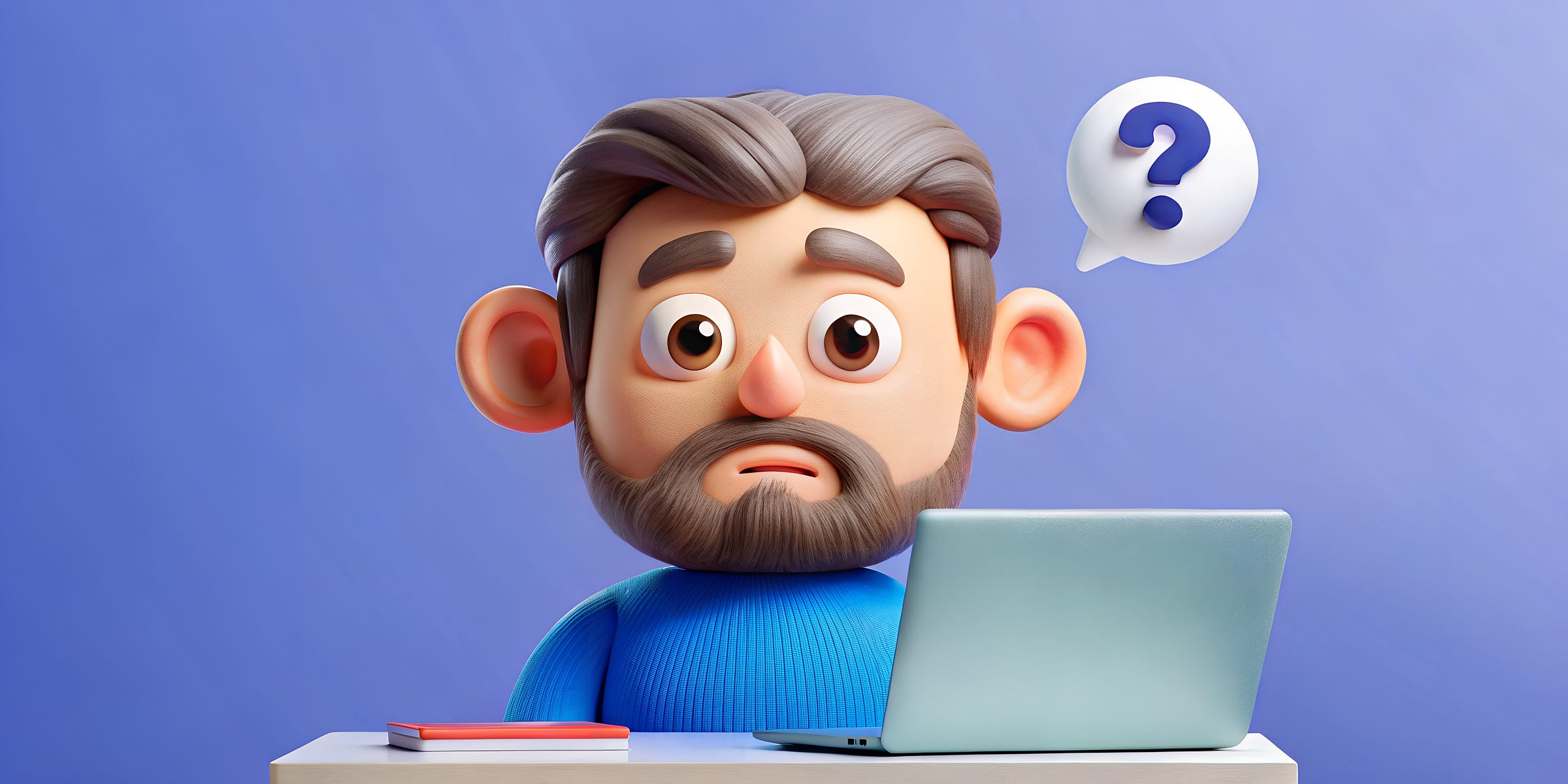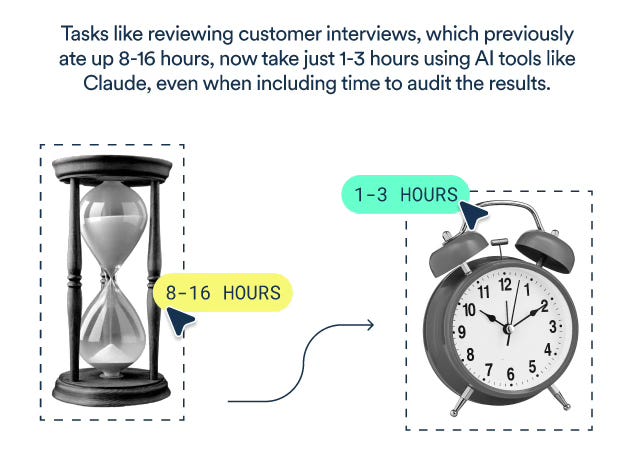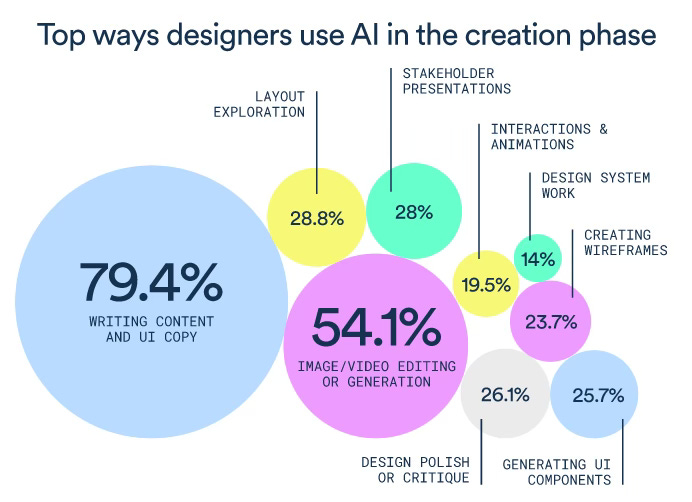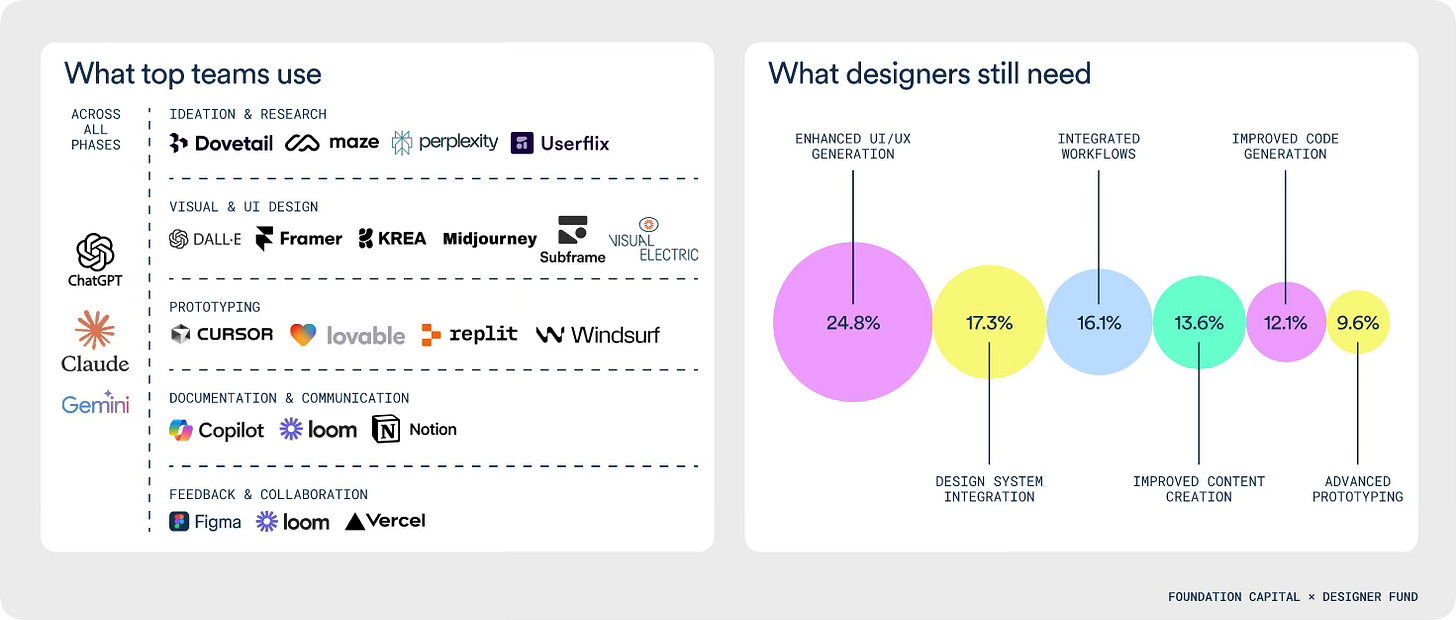The 32% Problem: Why Designers Don't Trust AI Like Developers Do
Only 32% of designers trust AI vs 82% of developers. With 42% of companies abandoning AI projects, here's what's actually working in design in 2025.
Only 32% of designers trust AI's output. Meanwhile, 82% of developers do.
This trust gap revealed in Figma's 2025 report, surveying 2,500 users, explains why design teams are struggling while engineering races ahead with AI adoption. It's not resistance to change. It's a fundamental mismatch between what AI delivers and what design actually needs.
The numbers get worse. S&P Global found that 42% of companies abandoned most of their AI initiatives in 2025, up from 17% last year. Cost estimates for generative AI projects have been off by 500% to 1000% in documented cases, turning manageable pilots into budget-breaking implementations.
Yet paradoxically, 89% of designers report that AI has improved their design process, according to Foundation Capital and Designer Fund. So what's really happening here?
We are in the middle of the biggest shift in design practice in over a decade. Amidst this disruption lies a genuine opportunity, especially for those willing to adapt, experiment, and lean into what humans do best: bring taste, context, and creative direction.
How AI is changing the way we design
You are right if you think AI has changed the overall creative industry. In fact, AI has started playing a critical role in each phase of design. Here are the three major stages of any design process where AI is helping across teams.
During design exploration & research
When working solo on a design project, our ideas are limited. When collaborating in a group, it remains limited to the collective exposure and experience of the group. However, with the advent of AI, this has expanded insanely. AI can support idea generation by providing fresh perspectives, unexpected directions, and creative solutions using all available information on the internet.
This broadens the group's collective experience, helping designers develop world-class solutions through faster research and exploration. This means we can spend less time staring at an empty canvas and have increased freedom of creative possibilities. If you struggle with the inertia, AI can generate the starting ideas, and you can take it from there. AI adds the confidence and builds the starting momentum for you.
Your role as designers becomes less about filling the space and more about exercising judgment, refining ideas, and developing a better design taste.
Treat AI as your assistant, available to you 24/7 with access to relevant data, rather than as a competitor ready to take over your job.
AI is also helping us save a significant amount of time by making sense of data received from product usage, UX research, and other sources. According to McKinsey's latest research, 78% of organizations now use AI in at least one business function, but the results vary dramatically by implementation approach.
When we create the design
Often, we are stuck in places where we work on some ideas/designs for weeks and months, only to realise later that the information hierarchy or overall design is not aligned with the goals or business outcomes. With AI, quick prototyping and feedback become faster, resulting in massive time savings.
In fact, a lot of designers are moving towards vibe coding. Vibe coding is an AI-powered method that helps teams quickly create functional prototypes using natural-language prompts instead of traditional design tools. Rather than following the path of wireframes first, then designs and prototyping, followed by engineering feedback, teams are skipping static mockups entirely and jumping directly into working products.
Startups like Perplexity exemplify this approach. They use AI-generated code to create functional prototypes and iterate based on actual user feedback. Designers can go to users faster and collect qualitative feedback rather than relying on early-design, abstract assumptions.
But vibe coding comes with significant trade-offs. It follows an 80/20 pattern that few discuss openly:
Weeks 1-2: Lightning-fast progress, impressive demos
Weeks 3-4: Hitting complexity walls, edge cases multiply
Week 5+: More time debugging AI-generated code than writing from scratch would take
The financial reality is sobering. Cost estimates for generative AI projects have been off by 500% to 1000% in documented cases, turning manageable pilots into budget-breaking implementations.
With AI, good enough is no longer sufficient. As AI advances and raises the standards, human-crafted exceptional designs become increasingly evident. The tools are powerful, but they're not magic.
When we deliver at the handoff stage
This is the stage where developers will have numerous questions regarding design decisions, interactions, documentation, assets, and so on. AI is helping at this stage, smoothing the process with accelerated speed.
This is still in the early stages of AI. It stumbles more often during execution and collaboration. Hallucinations have been drastically reduced, yet it still often feels AI-generated for most of the content and processes out there. It can generate ideas and help us validate those ideas with research points, but shaping those ideas into polished products still remains within the realm of human creativity.
S&P Global found that 42% of companies abandoned most of their AI initiatives in 2025, up from 17% last year. The average organization scrapped 46% of AI proof-of-concepts before they reached production.
What's not working across teams, tools and roles
The AI landscape is changing so rapidly that designers are hesitant to commit until tools show clear, lasting value. There are very few tools like ChatGPT, Perplexity, Claude, and others that could take that place so far. It’s more like the early stage of dating, where there is a lot of exploration before any commitments, because of this.
Take Figma's Make Designs feature. Shortly after launch, they discovered their AI was generating mocks that resembled existing apps. They had to temporarily roll back the feature. Even the most sophisticated design tools struggle with originality, a core requirement of good design.
This is not an isolated incident. AI design tools hold tremendous promise, but when it comes to real-world implementation, they're failing in four critical areas:
Fragmented ecosystems are killing productivity. Designers juggle prototypes on temporary links, give feedback across Figma, Notion, Loom, and Miro, then struggle to sync work with non-designers. Instead of saving time, teams spend hours managing tool sprawl.
The switching costs are brutal. Tools promise speed but require completely new workflows and weeks of onboarding.
"Right now, the landscape feels too early to bet on a horse. We could train everyone to use Midjourney and Cursor but next week it could be something else."
- Katie Dill, Head of Design at Stripe
Reliability remains a fantasy. AI output is inconsistent, generic, or filled with hallucinations. This creates more work, not less. Teams report spending more time fixing AI mistakes than they saved in the initial generation.
Privacy & Security concerns paralyze enterprises. Fast-growing startups and established companies remain cautious about AI tools because of legitimate fears around sensitive data and IP leakage. Without clear governance, adoption stalls.
AI in design is mostly a personal productivity tool rather than the team-wide transformation vendors promised. More than 90% of designers are learning new AI tools through peers, social media, or personal curiosity and not through official channels. The tools that have gained traction succeeded by being reliable generalists, not specialized design solutions.
How should we proceed further?
More than 90% of designers are learning and discovering new AI tools through peers, social media, or personal curiosity rather than formal channels.
For companies aiming to become "AI-first", buzzwords and email from the management to use AI are not enough. Everyone in the team needs practical support in the form of Loom videos, learning resources, what to use when videos, detailed company-wide documentations, publicly available guidelines inside the company and most importantly, plenty of opportunities to apply what they learned.
For designers, this presents a golden opportunity. Don't wait around for an official memo, start experimenting now. Master the art of prompt engineering and get familiar with the landscape firsthand. You should be able to answer when to use Perplexity vs Claude Research, and how Replit is different from Lovable or v0? Become the person your colleagues can trust to sort through the confusion and share what you learn widely.
"There's a learning curve and only organizations that truly prioritize education and testing have a chance to see real benefits. Many are just 'doing AI' to feel good."
- Lior Albeck, CEO & Co-founder, Weavy
Interestingly, early-stage startups are adopting AI at double the rate of larger ones. And it absolutely makes sense. Fewer people in the company means faster adoption due to faster process change, close environment learning and better adaptations. Larger companies are held back by fears about privacy, security, tech debt and legal hurdles.
Figma's research reveals that the proportion of users at small companies who see AI as essential has doubled since last year. Small teams (under 50) show a 78% adoption rate with a 62% success rate, while enterprise teams (500+) show only 45% adoption with a 31% success rate.
Still, even half of the startups haven't gone all-in on AI, showing a massive opportunity to take this technology at its core and implement it in daily workflows.
AI is opening the door to design on a broader scale than ever, but not without significant downsides. That means creating a design is not a barrier anymore. With the right tool and a good prompt, anyone can start designing. But the market will be flooded with generic design, everything looks the same and repetitive. And this is the best time to bring your uniqueness as a designer. Creativity matters more than ever.
Develop a good sense of design, start identifying patterns in AI, including patterns in designs created by AI, and understand the tools & their limitations. This will help you understand your differentiation factor. This differentiation factor will be your superpower against AI.
According to RAND Corporation, AI projects fail because organizations focus more on using the latest technology than solving real problems for their intended users.
"Brand and taste become the enduring differentiators in a world where the means of production are widely accessible."
- David Hong, Head of Design (AI), Atlassian
These are the things to help you navigate these unknown waters of the AI shift in design industries:
Think in workflows and not in screens: Understand the full user journey and how the product is taking shape.
Master the business language: Discuss the business impacts across departments, rather than focusing on the design itself.
Develop product thinking and become a generalist who is comfortable with design, storytelling, product development, and prototyping.
Understand how AI and technology work. You don't need to be an expert, but you should know how it works. This will help you make better decisions about the next steps in the project.
Identify your unique approach. Every designer has a different style, bring your taste out. Refine your instincts, sharpen your taste, and develop your ability to recognize what can go into the final product.
Design is having its Napster moment. Just as digital music destroyed the recording industry's business model overnight, AI is obliterating the traditional design process. McKinsey data shows 78% of companies have adopted AI, but only 20% of designers use it for core design work. The rest are watching their profession get disrupted in real-time.
The winners in 2025 won't be those who use the most AI. They will be those who know exactly when not to use it. The real question is not whether AI will replace designers. It's whether designers will have the courage to let AI handle the boring parts so they can focus on what machines can't do: create work that makes people feel something.
Your move.
If you liked this one, you might find these interesting









